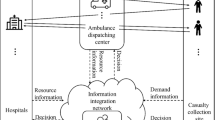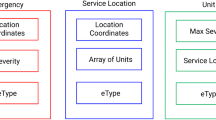Abstract
Whenever a mass casualty disaster takes place, the medical infrastructure available has to deal with a surge in the number or patients severely ill or injured. Using triage methods casualties have to be prioritized to receive health care in a limited-resource scenario. Aiming to do the greatest good to the greatest number of people, it has to be determined how to make the best use of these resources. This constitutes a very complex task that has to consider issues such as the current number of casualties, their lifetime expectancy, their resource consumption, etc. We approach this task within the framework of the pilot method and hyperheuristics. We show how these metaheuristics can effectively manage a number of simpler heuristics, providing improved results on an ample set of simulated problem scenarios. An exhaustive empirical evaluation analyzes the influence on performance of factors such as the total number of casualties, the severity of their medical condition, the treatment time, the number of resources available, or the number of triage classes.
Similar content being viewed by others
References
Argon NT, Ziya S, Righter R (2008) Scheduling impatient jobs in a clearing system with insights on patient triage in mass casualty incidents. Probab Eng Inform Sci 22(3): 301–332
Bar-Joseph G, Michaelson M, Halberthal M (2003) Managing mass casualties. Curr Opin Anaesthesiol 16: 193–199
Bostick N et al (2008) Disaster triage systems for large-scale catastrophic events. Disaster Med Public Health Prep 2(Suppl 1): S35–S39
Burke E et al (2003) Hyper-heuristics: an emerging direction in modern search technology. In: Glover F, Kochenberger G (eds) Handbook of metaheuristics. International series in operations research and management science, vol 57. Kluwer, Dordertcht, pp 457–474
Chakhlevitch K, Cowling PI (2008) Hyperheuristics: Recent developments. In: Cotta C, Sevaux M, Sörensen K (eds) Adaptive and multilevel metaheuristics. Studies in computational intelligence, vol 136. Springer, Berlin, pp 3–29
Challen K et al (2007) Clinical review: mass casualty triage–f́bpandemic influenza and critical care. Crit Care 11: 212–216
Cone DC, MacMillan DS (2005) Mass-casualty triage systems: a hint of science. Acad Emerg Med 12(8): 739–741
Cowling PI, Kendall G, Soubeiga E (2000) A hyperheuristic approach to scheduling a sales summit. In: Burke EK, Erben W (eds) Practice and theory of automated timetabling III Lecture notes in computer science, vol 2079. Springer, Konstanz, pp 176–190
Daniels N (2000) Accountability for reasonableness. BMJ 321: 1300–1301
Doerner KF, Hartl RF (2008) Health care logistics, emergency preparedness, and disaster relief: new challenges for routing problems with a focus on the Austrian situation. In: Golden B et al (eds) The vehicle routing problem: latest advances and new challenges Operations research/computer science interfaces series, vol 43. Springer, Berlin, pp 527–550
Duin C, Voß S (1994) Steiner tree heuristics—a survey. In: Dyckhoff H et al (eds) Operation research proceedings 1993 (DGOR-NSOR), Springer, Berlin, pp 485–496
Duin C, Voß S (1999) The pilot method: a strategy for heuristic repetition with application to the Steiner problem in graphs. Networks 34: 181–191
Friedman M (1937) The use of ranks to avoid the assumption of normality implicit in the analysis of variance. J Am Stat Assoc 32(200): 675–701
Frykberg E (2004) Principles of mass casualty management following terrorist disasters. Ann Surg 239(3): 319–321
Garner A et al (2001) Comparative analysis of multiple-casualty incident triage algorithms. Ann Emerg Med 38(5): 541–548
Glazebrook K et al (2004) On the optimal allocation of service to impatient tasks. J Appl Probab 41(1): 51–72
Good L (2008) Ethical decision making in disaster triage. J Emerg Nurs 34(2): 112–115
Hick J, Barbera J, Kelen G (2009) Refining surge capacity: conventional, contingency, and crisis capacity. Disaster Med Public Health Prep 3(Suppl 1): S59–S67
Hick J et al (2007) Clinical review: allocating ventilators during large-scale disasters - problems, planning, and process. Crit Care 11(3): 217–225
Hirshberg A (2004) Multiple casualty incidents. Lessons from the front line. Ann Surg 239(3): 322–324
Holm S (1979) A simple sequentially rejective multiple test procedure. Scand J Stat 6: 65–70
Iman R, Davenport J (1980) Approximations of the critical region of the Friedman statistic. Commun Stat 9: 571–595
Iserson KV, Moskop JC (2007) Triage in medicine, part I: Concept, history, and types. Ann Emerg Med 49(3): 275–281
Kennedy K et al (1996) Triage: techniques and applications in decisionmaking. Ann Emerg Med 28(2): 136–144
Koenig KL, Dinerman N, Kuehl AE (1996) Disaster nomenclature—a functional impact approach: the PICE system. Acad Emerg Med 3(7): 723–727
Larkin G, Arnold J (2003) Ethical considerations in emergency planning, preparedness, and response to acts of terrorism. Prehosp Disaster Med 18(3): 170–178
Lee ET, Wang JW (2003) Statistical methods for survival data analysis. Wiley, Hoboken
Lee EK et al (2009) Facility location and multi-modality mass dispensing strategies and emergency response for biodefence and infectious disease outbreaks. Int J Risk Assess Manage 12: 311–351
Özcan E, Bilgin B, Korkmaz EE (2008) A comprehensive analysis of hyper-heuristics. Intell Data Anal 12(1):3–23
Peleg K et al (2004) Gunshot and explosion injuries: characteristics, outcomes, and implications for care of terror-related injuries in Israel. Ann Surg 239(3): 311–318
Robertson-Steel I (2006) Evolution of triage systems. Emerg Med J 23(2): 154–155
Roccaforte J, Cushman J (2007) Disaster preparedness, triage, and surge capacity for hospital definitive care areas: Optimizing outcomes when demands exceed resources. Anesthesiol Clin 25(1): 161–177
Rubinson L et al (2005) Augmentation of hospital critical care capacity after bioterrorist attacks or epidemics: recommendations of the working group on emergency mass critical care. Crit Care Med 33: 2393–2403
Saffle J, Gibran N, Jordan M (2005) Defining the ratio of outcomes to resources for triage of burn patients in mass casualties. J Burn Care Rehabil 26: 478–482
Super G (1984) START: A triage training module. Hoag Memorial Presbyterian, Newport Beach
Stein M, Hirshberg A (1999) Medical consequences of terrorism. The conventional weapon threat. Surg Clin North Am 79: 1537–1552
Tatomir B, Rothkrantz L (2006) Ant based mechanism for crisis response coordination. In: Dorigo M et al (eds) Ant colony optimization and swarm intelligence. Lecture notes in computer science, vol 4150. Springer, Brussels, pp 380–387
van Veelen J, van Aart C, Storms P (2006) Effective and efficient coordination strategies for agile crisis response organizations. In: de Walle BV, Turoff M (eds) Proceedings of the 3rd international ISCRAM conference, Newark, pp 202–213
Voß S, Fink A, Duin C (2005) Looking ahead with the pilot method. Ann Oper Res 136(1): 285–302
Weibull W (1951) A statistical distribution function of wide applicability. J Appl Mech 18(3): 293–297
Wilcoxon F (1945) Individual comparisons by ranking methods. Biometrics 1: 80–83
Author information
Authors and Affiliations
Corresponding author
Additional information
This work is supported by Spanish Ministerio de Ciencia e Innovación under project TIN2008-05941 (Project NEMESIS).
Rights and permissions
About this article
Cite this article
Cotta, C. Effective patient prioritization in mass casualty incidents using hyperheuristics and the pilot method. OR Spectrum 33, 699–720 (2011). https://doi.org/10.1007/s00291-011-0238-3
Published:
Issue Date:
DOI: https://doi.org/10.1007/s00291-011-0238-3




